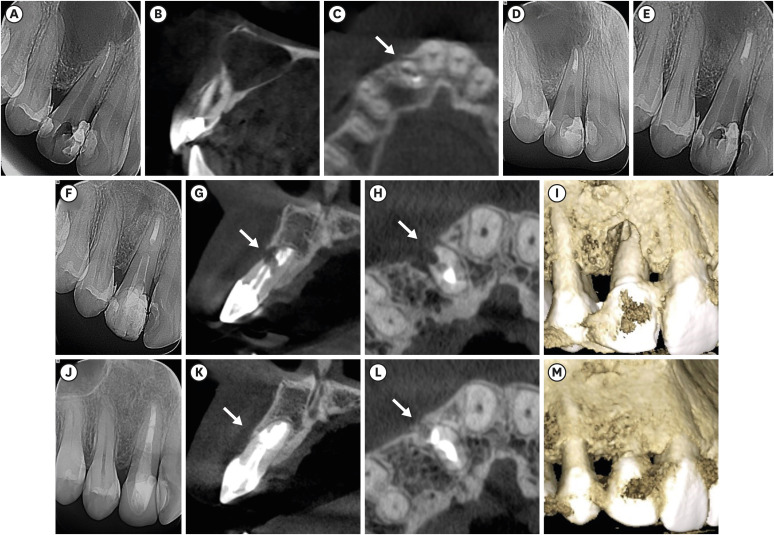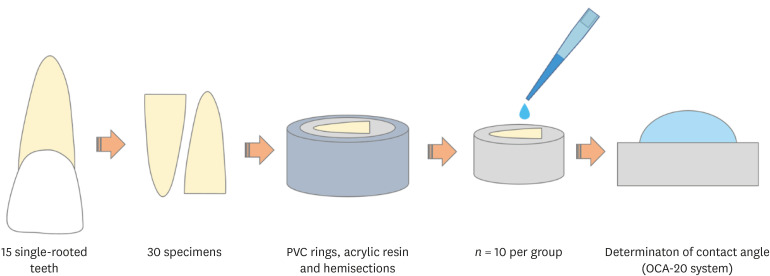-
Endodontic micro-resurgery and guided tissue regeneration of a periapical cyst associated to recurrent root perforation: a case report
-
Fernando Córdova-Malca, Hernán Coaguila-Llerena, Lucía Garré-Arnillas, Jorge Rayo-Iparraguirre, Gisele Faria
-
Restor Dent Endod 2022;47(4):e35. Published online September 3, 2022
-
DOI: https://doi.org/10.5395/rde.2022.47.e35
-
-
 Abstract Abstract
 PDF PDF PubReader PubReader ePub ePub
Although the success rates of microsurgery and micro-resurgery are very high, the influence of a recurrent perforation combined with radicular cyst remains unclear. A 21-year-old white female patient had a history of root perforation in a previously treated right maxillary lateral incisor. Analysis using cone-beam computed tomography (CBCT) revealed an extensive and well-defined periapical radiolucency, involving the buccal and palatal bone plate. The perforation was sealed with bioceramic material (Biodentine) in the pre-surgical phase. In the surgical phase, guided tissue regeneration (GTR) was performed by combining xenograft (lyophilized bovine bone) and autologous platelet-rich fibrin applied to the bone defect. The root-end preparation was done using an ultrasonic tip. The retrograde filling was performed using a bioceramic material (Biodentine). Histopathological analysis confirmed a radicular cyst. The patient returned to her referring practitioner to continue the restorative procedures. CBCT analysis after 1-year recall revealed another perforation in the same place as the first intervention, ultimately treated by micro-resurgery using the same protocol with GTR, and a bioceramic material (MTA Angelus). The 2-year recall showed healing and bone neoformation. In conclusion, endodontic micro-resurgery with GTR showed long-term favorable results when a radicular cyst and a recurrent perforation compromised the success. -
Citations
Citations to this article as recorded by  - Management of Apico-marginal Defects With Endodontic Microsurgery and Guided Tissue Regeneration: A Report of Thirteen Cases
Abayomi O. Baruwa, Jorge N.R. Martins, Mariana D. Pires, Beatriz Pereira, Pedro May Cruz, António Ginjeira
Journal of Endodontics.2023; 49(9): 1207. CrossRef
-
314
View
-
12
Download
-
2
Web of Science
-
1
Crossref
-
Outcomes of the GentleWave system on root canal treatment: a narrative review
-
Hernán Coaguila-Llerena, Eduarda Gaeta, Gisele Faria
-
Restor Dent Endod 2022;47(1):e11. Published online February 14, 2022
-
DOI: https://doi.org/10.5395/rde.2022.47.e11
-
-
 Abstract Abstract
 PDF PDF PubReader PubReader ePub ePub
This study aimed to describe the outcomes of the GentleWave system (GW) (Sonendo) on root canal treatment. Published articles were collected from scientific databases (MEDLINE/PubMed platform, Web of Science, Scopus, Science Direct and Embase). A total of 24 studies were collected from August/2014 to July/2021, 20 in vitro and 4 clinical. GW System was not associated with extrusion of the irrigant, promoted faster organic dissolution than conventional syringe irrigation (CSI), passive ultrasonic irrigation (PUI) continuous ultrasonic irrigation (CUI) and EndoVac, reduced more bacterial DNA and biofilm than PUI and CUI, promoted higher penetration of sodium hypochlorite into dentinal tubules than PUI and CUI in vitro, and removed more intracanal medication than CSI and PUI. GW was able to remove pulp tissue and calcifications. Moreover, its ability to remove hard-tissue debris and smear layer was better than that of CSI, and its ability to remove root canal obturation residues was lower or similar to that of PUI, and similar to that of CSI and EndoVac. Regarding root canal obturation of minimally instrumented molar canals, GW was associated with high-quality obturation. Clinically, the success rate of endodontic treatment using GW was 97.3%, and the short-term postoperative pain in the GW group was not different from CSI. Further research, mainly clinical, is needed to establish whether GW has any advantages over other available irrigation methods. -
Citations
Citations to this article as recorded by  - Use of the gentlewave system in endodonticsUse of the gentlewave system in endodontics
Daiana Jacobi Lazzarotto, Mayara Colpo Prado, Lara Dotto, Rafael Sarkis-Onofre
Brazilian Journal of Oral Sciences.2025; 24: e254250. CrossRef - A Comparison Between Multisonic and Ultrasonic Irrigant Activation Techniques for Multispecies Biofilm Removal During Root Canal Disinfection: A Systematic Review
Preethi Varadan, Sangavi Ra, Mathan R Rajendran
Cureus.2025;[Epub] CrossRef - The effect of ultrasonic and multisonic irrigation on root canal microbial communities: An ex vivo study
Ki Hong Park, Ronald Ordinola‐Zapata, W. Craig Noblett, Bruno P. Lima, Christopher Staley
International Endodontic Journal.2024; 57(7): 895. CrossRef - An Experimental Anatomic CBCT Study on the Correlations Between MB1 and MB2 of the Mesio-Vestibular Root of the Upper First Molars
Luca Fiorillo, Cesare D’Amico, Giusy Rita Maria La Rosa, Francesco Calanna, Alfio Pappalardo, Eugenio Pedullà
Journal of Craniofacial Surgery.2024; 35(2): 672. CrossRef - Bioceramics in Endodontics: Updates and Future Perspectives
Xu Dong, Xin Xu
Bioengineering.2023; 10(3): 354. CrossRef - Comparative analysis of the effectiveness of modern irrigants activation techniques in the process of mechanical root canal system treatment (Literature review)
Anatoliy Potapchuk, Vasyl Almashi, Arsenii Horzov, Victor Buleza
InterConf.2023; (34(159)): 200. CrossRef - Evaluation of machine-assisted irrigation on removal of intracanal biofilm and extrusion of sodium hypochlorite using a three-dimensionally printed root canal model
Ji-Yoon Shin, Mi-Ah Kim, Hee-Jin Kim, Prasanna Neelakantan, Mi-Kyung Yu, Kyung-San Min
Journal of Oral Science.2023; 65(3): 158. CrossRef - Analysis of the efficiency of sound impact on the system of canals of the tooth root: A laboratory study
Anatolii A. Adamchik, Valerii V. Tairov, Irina O. Kamyshnikova, Ekaterina S. Zaporozhskaya-Abramova, Zhanna V. Solovyeva, Viktoria A. Ivashchenko, Natalia V. Lapina, Armenak V. Arutyunov, Olga N. Risovannaya, Ksenia D. Kirsch, Valeria D. Golubina
Russian Journal of Dentistry.2023; 27(4): 261. CrossRef - Multispecies biofilm removal by a multisonic irrigation system in mandibular molars
Hernán Coaguila‐Llerena, Ronald Ordinola‐Zapata, Christopher Staley, Matthew Dietz, Ruoqiong Chen, Gisele Faria
International Endodontic Journal.2022; 55(11): 1252. CrossRef
-
492
View
-
16
Download
-
5
Web of Science
-
9
Crossref
-
Physicochemical properties, cytotoxicity and penetration into dentinal tubules of sodium hypochlorite with and without surfactants
-
Hernán Coaguila-Llerena, Isadora Barbieri, Mário Tanomaru-Filho, Renato de Toledo Leonardo, Ana Paula Ramos, Gisele Faria
-
Restor Dent Endod 2020;45(4):e47. Published online September 10, 2020
-
DOI: https://doi.org/10.5395/rde.2020.45.e47
-
-
 Abstract Abstract
 PDF PDF PubReader PubReader ePub ePub
- Objectives
The aim of this study was to assess the physicochemical properties, cytotoxicity and penetration into dentinal tubules of ChlorCid™ Surf (3% sodium hypochlorite [NaOCl] with surfactant) in comparison to ChlorCid™ (3% NaOCl without surfactant). Materials and MethodsThe physicochemical properties evaluated were pH, surface tension, free available chlorine (FAC) and contact angle. Cytotoxicity was evaluated in L929 fibroblasts exposed to the solutions by 3-(4,5-dimethylthiazol-2-yl)-2,5-diphenyl tetrazolium bromide and neutral red assays. Assessment of penetration into dentinal tubules was performed by staining single-rooted permanent human teeth with crystal violet (n = 9), which were irrigated with the solutions and analyzed in cervical, middle and apical segments. Data were analyzed by one-way analysis of variance (ANOVA) and Tukey's post-test, 2-way ANOVA and Bonferroni's post-test or t-test (α = 0.05). ResultsChlorCid™ Surf and ChlorCid™ FAC values were close to those indicated by the manufacturer. ChlorCid™ Surf showed lower surface tension and contact angle on dentin, and higher pH than ChlorCid™ (p < 0.05). The penetration of ChlorCid™ Surf was higher in cervical and middle segments, compared with ChlorCid™ (p < 0.05). There was no difference in irrigant cytotoxicity (p > 0.05). ConclusionsChlorCid™ Surf showed lower surface tension, lower contact angle on root canal dentin, higher penetration into dentinal tubules and more alkaline pH, compared with ChlorCid™. However, both solutions showed similar cytotoxicity and FAC content.
-
Citations
Citations to this article as recorded by  - Research methods assessing sodium hypochlorite cytotoxicity: A scoping review
Hernán Coaguila-Llerena, Luana Raphael da Silva, Gisele Faria
Heliyon.2024; 10(1): e23060. CrossRef - Amelioration in the sodium hypochlorite as root canal irrigant – A review
Preety Sehrawat
International Dental Journal of Student's Research.2024; 12(2): 65. CrossRef - Sonic-assisted antibacterial photodynamic therapy: a strategy for enhancing lateral canal disinfection
Yanhuang Wang, Lishan Lei, Jing Huang, Zhiyu Cai, Xiaojing Huang
BMC Oral Health.2024;[Epub] CrossRef - A Comparative Evaluation of Contact Angle and Depth of Penetration of Sodium Hypochlorite With Various Surfactants: An In Vitro Study
Shubhashini N, Krithika D, Akhilesh Gowda , Shruthi Nagaraja , Rhea S Mathew, Nivaskumar G A, Vinaychandra R
Cureus.2024;[Epub] CrossRef - Antibacterial efficacy of silver nanoparticles, sodium hypochlorite, chlorhexidine, and hypochlorous acid on dentinal surfaces infected with Enterococcus faecalis
Aysenur Oncu, Berkan Celikten, Betül Aydın, Gulin Amasya, Erkan Tuncay, Gamze Guney Eskiler, Leyla Açık, Fatma Semra Sevimay
Microscopy Research and Technique.2024; 87(9): 2094. CrossRef - Advances in the Role of Sodium Hypochlorite Irrigant in Chemical Preparation of Root Canal Treatment
Chen Cai, Xuan Chen, Yang Li, Qianzhou Jiang, Yeliz Guven
BioMed Research International.2023;[Epub] CrossRef - Effect of sodium hypochlorite-based formulations on the adhesion interface after fiber post cementation
Joatan Lucas de Sousa Gomes COSTA, Tatiane Miranda MANZOLI, João Felipe BESEGATO, Joissi Ferrari ZANIBONI, Eliane Cristina Gulin DE OLIVEIRA, Lucas David GALVANI, Andréa Abi Rached DANTAS, Luis Geraldo VAZ, Milton Carlos KUGA
Dental Materials Journal.2023; 42(6): 878. CrossRef - Physicochemical properties and penetration into dentinal tubules of calcium hypochlorite with surfactants
Hernán Coaguila-Llerena, Julia da Silva Toledo, Ana Paula Ramos, Gisele Faria
Brazilian Dental Journal.2022; 33(2): 1. CrossRef
-
296
View
-
7
Download
-
8
Crossref
|










